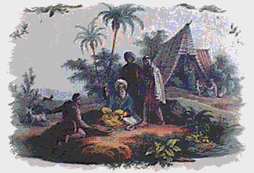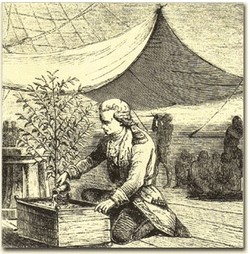The History of Coffee

Coffee Origins
In the Ethiopian mountains, the legend of Kaldi, the goat herder, originated where coffee trees grow today as they have for centuries. It is said that he discovered coffee after noticing that his goats upon eating berries from a certain tree became spirited and did not want to sleep at night. They have become to be known as the dancing goats.
Kaldi reported his findings to the abbot of the local monastery in which a monk made a drink by boiling the berries and discovered that it kept him alert for the long hours of evening prayer. Soon the Abbot had shared this discovery with other monks at the monastery, and ever so slowly knowledge of the energizing effects of the berries began to spread. Later, a particularly curious monk, who liked the sweet aroma of a burning coffee branch, pulled the charred berries from the fire, ground them down, and prepared a black beverage. This dark liquid beverage was believed to be the first making of a coffee. The word “coffee” is believed to be derived from the name of the place, 'kaffa" in southern Ethiopia, where coffee was cultivated.
As word moved east and coffee reached the Arabian peninsula, it began a journey which would spread its reputation across the globe. Today coffee is grown in a multitude of countries around the world. Whether it is Asia or Africa, Central or South America, the islands of the Caribbean or Pacific, all can trace their heritage to the trees in the ancient coffee forests on the Ethiopian plateau.
In the Ethiopian mountains, the legend of Kaldi, the goat herder, originated where coffee trees grow today as they have for centuries. It is said that he discovered coffee after noticing that his goats upon eating berries from a certain tree became spirited and did not want to sleep at night. They have become to be known as the dancing goats.
Kaldi reported his findings to the abbot of the local monastery in which a monk made a drink by boiling the berries and discovered that it kept him alert for the long hours of evening prayer. Soon the Abbot had shared this discovery with other monks at the monastery, and ever so slowly knowledge of the energizing effects of the berries began to spread. Later, a particularly curious monk, who liked the sweet aroma of a burning coffee branch, pulled the charred berries from the fire, ground them down, and prepared a black beverage. This dark liquid beverage was believed to be the first making of a coffee. The word “coffee” is believed to be derived from the name of the place, 'kaffa" in southern Ethiopia, where coffee was cultivated.
As word moved east and coffee reached the Arabian peninsula, it began a journey which would spread its reputation across the globe. Today coffee is grown in a multitude of countries around the world. Whether it is Asia or Africa, Central or South America, the islands of the Caribbean or Pacific, all can trace their heritage to the trees in the ancient coffee forests on the Ethiopian plateau.

The Arabian Peninsula
The Arabs were the first, not only to cultivate coffee but also to begin its trade. By the fifteenth century, coffee was being grown in the Yemeni district of Arabia and by the sixteenth century it was known in Persia, Egypt, Syria and Turkey. It's popularity was perhaps due, in part, to the fact that Muslims, forbidden alcoholic drink by the Koran, found coffee's energizing properties to be an acceptable substitute.
The Arabs were the first, not only to cultivate coffee but also to begin its trade. By the fifteenth century, coffee was being grown in the Yemeni district of Arabia and by the sixteenth century it was known in Persia, Egypt, Syria and Turkey. It's popularity was perhaps due, in part, to the fact that Muslims, forbidden alcoholic drink by the Koran, found coffee's energizing properties to be an acceptable substitute.

Coffee was not only drunk in homes but also in the many public coffee houses -- called qahveh khaneh -- which began to appear in cities across the Near East. The popularity of the coffee houses was unequaled and people frequented them for all kinds of social activity. Not only did they drink coffee and engage in conversation, but they also listened to music, watched performers, played chess and kept current on the news of the day. In fact, they quickly became such an important center for the exchange of information that the coffee houses were often referred to as 'Schools of the Wise.'
With thousands of pilgrims visiting the holy city of Mecca each year from all over the world, word of the 'wine of Araby' as the drink was often called, was beginning to spread far beyond Arabia. In an effort to maintain its complete monopoly in the early coffee trade, the Arabians continued to closely guard their coffee production.
With thousands of pilgrims visiting the holy city of Mecca each year from all over the world, word of the 'wine of Araby' as the drink was often called, was beginning to spread far beyond Arabia. In an effort to maintain its complete monopoly in the early coffee trade, the Arabians continued to closely guard their coffee production.

Coffee Comes to Europe
European travelers to the Near East brought back stories of the unusual dark black beverage. By the 17th century, coffee had made its way to Europe and was becoming popular across the continent. Opponents were overly cautious, calling the beverage the 'bitter invention of Satan.' With the coming of coffee to Venice in 1615, the local clergy condemned it. The controversy was so great that Pope Clement VIII was asked to intervene. Before making a decision however, he decided to taste the beverage for himself. He found the drink so satisfying that he gave it Papal approval.
European travelers to the Near East brought back stories of the unusual dark black beverage. By the 17th century, coffee had made its way to Europe and was becoming popular across the continent. Opponents were overly cautious, calling the beverage the 'bitter invention of Satan.' With the coming of coffee to Venice in 1615, the local clergy condemned it. The controversy was so great that Pope Clement VIII was asked to intervene. Before making a decision however, he decided to taste the beverage for himself. He found the drink so satisfying that he gave it Papal approval.

Despite such controversy, in the major cities of England, Austria, France, Germany and Holland, coffee houses were quickly becoming centers of social activity and communication. In England 'penny universities' sprang up, so called because for the price of a penny one could purchase a cup of coffee and engage in stimulating conversation. By the mid-17th century, there were over 300 coffee houses in London, many of which attracted patrons with common interests, such as merchants, shippers, brokers and artists. Many businesses grew out of these specialized coffee houses. Lloyd's of London, for example, came into existence at the Edward Lloyd's Coffee House.

The New World
In the mid-1600's, coffee was brought to New Amsterdam, a location later called New York by the British. Though coffee houses rapidly began to appear, tea continued to be the favored drink in the New World until 1773 when the colonists revolted against a heavy tax on tea imposed by King George. The revolt, known as the Boston Tea Party, would forever change the American drinking preference to coffee.
In the mid-1600's, coffee was brought to New Amsterdam, a location later called New York by the British. Though coffee houses rapidly began to appear, tea continued to be the favored drink in the New World until 1773 when the colonists revolted against a heavy tax on tea imposed by King George. The revolt, known as the Boston Tea Party, would forever change the American drinking preference to coffee.

Plantations Around the World
As demand for the beverage continued to spread, there was tense competition to cultivate coffee outside of Arabia. Though the Arabs tried hard to maintain their monopoly, the Dutch finally succeeded, in the latter half of the 17th century, to obtain some seedlings. Their first attempts to plant them in India failed but they were successful with their efforts in Batavia, on the island of Java in what is now Indonesia. The plants thrived and soon the Dutch had a productive and growing trade in coffee. They soon expanded the cultivation of coffee trees to the islands of Sumatra and Celebes.
As demand for the beverage continued to spread, there was tense competition to cultivate coffee outside of Arabia. Though the Arabs tried hard to maintain their monopoly, the Dutch finally succeeded, in the latter half of the 17th century, to obtain some seedlings. Their first attempts to plant them in India failed but they were successful with their efforts in Batavia, on the island of Java in what is now Indonesia. The plants thrived and soon the Dutch had a productive and growing trade in coffee. They soon expanded the cultivation of coffee trees to the islands of Sumatra and Celebes.

The Dutch did a curious thing, however. In 1714, the Mayor of Amsterdam presented a gift of a young coffee plant to King Louis XIV of France. The King ordered it to be planted in the Royal Botanical Garden in Paris. In 1723, a young naval officer, Gabriel de Clieu obtained a seedling from the King's plant. Despite an arduous voyage -- complete with horrendous weather, a saboteur who tried to destroy the seedling and a pirate attack -- he managed to transport it safely to Martinique. Once planted, the seedling thrived and is credited with the spread of over 18 million coffee trees on the island of Martinique in the next 50 years. It was also the stock from which coffee trees throughout the Caribbean, South and Central America originated.

Coffee is said to have come to Brazil in the hands of Francisco de Mello Palheta who was sent by the emperor to French Guiana for the purpose of obtaining coffee seedlings. But the French were not willing to share and Palheta was unsuccessful. However, he was said to have been so handsomely engaging that the French Governor's wife was captivated. As a going-away gift, she presented him with a large bouquet of flowers. Buried inside he found enough coffee seeds to begin what is today a billion-dollar industry.

In only 100 years, coffee had established itself as a commodity crop throughout the world. Missionaries and travelers, traders and colonists continued to carry coffee seeds to new lands and coffee trees were planted worldwide. Plantations were established in magnificent tropical forests and on rugged mountain highlands. Some crops flourished, while others were short-lived. New nation's were established on coffee economies. Fortunes were made and lost. And by the end of the 18th century, coffee had become one of the world's most profitable export crops. Today, the coffee bean market alone has developed into an industry approaching $40 billion annually.
Courtesy of the National Coffee Association
Courtesy of the National Coffee Association
